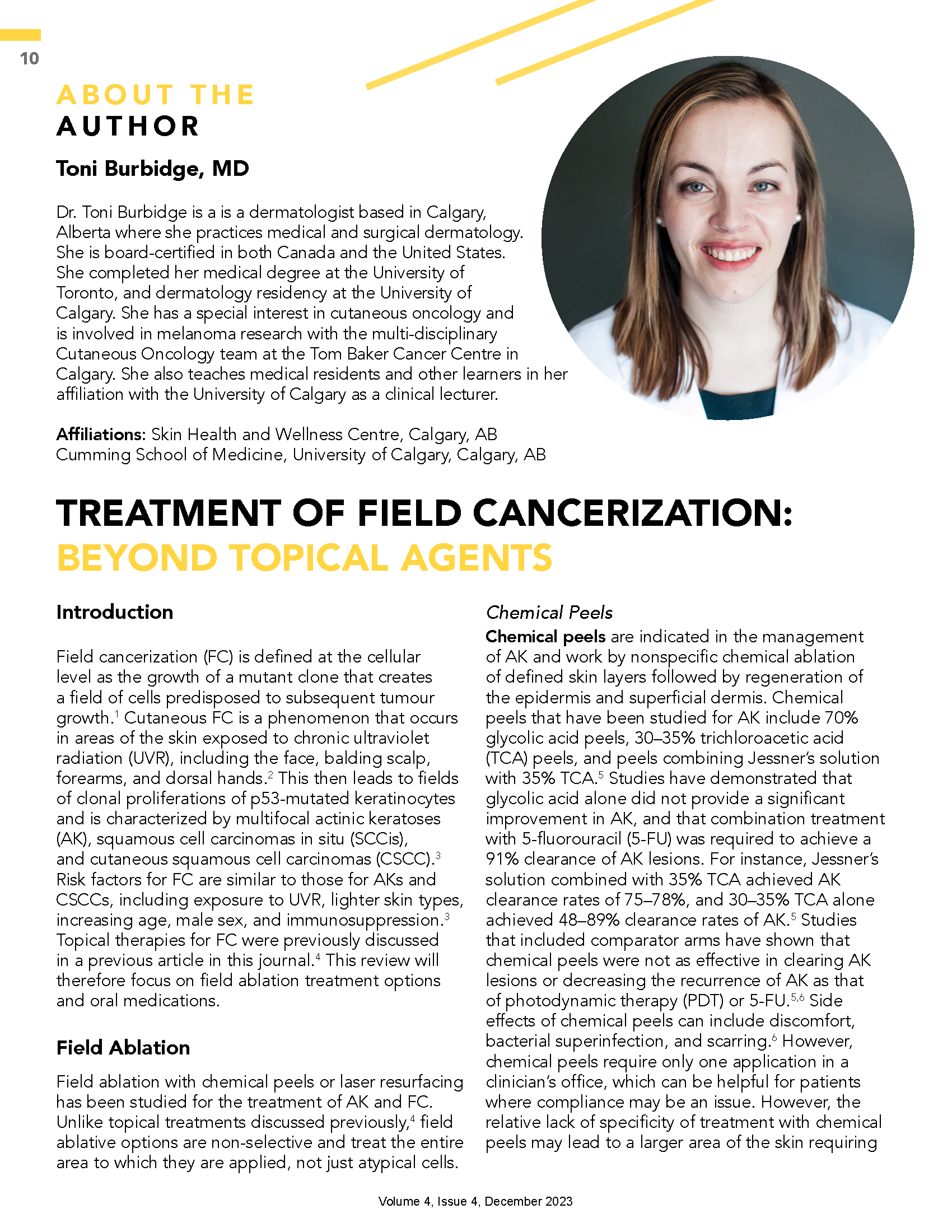Treatment of Field Cancerization: Beyond Topical Agents
Abstract
Field cancerization (FC) is defined at the cellular level as the growth of a mutant clone that creates a field of cells predisposed to subsequent tumour growth. Cutaneous FC is a phenomenon that occurs in areas of the skin exposed to chronic ultraviolet radiation (UVR), including the face, balding scalp, forearms, and dorsal hands. This then leads to fields of clonal proliferations of p53-mutated keratinocytes and is characterized by multifocal actinic keratoses (AK), squamous cell carcinomas in situ (SCCis), and cutaneous squamous cell carcinomas (CSCC). Risk factors for FC are similar to those for AKs and CSCCs, including exposure to UVR, lighter skin types, increasing age, male sex, and immunosuppression. Topical therapies for FC were previously discussed in a previous article in this journal. This review will therefore focus on field ablation treatment options and oral medications.
References
Braakhuis BJ, Tabor MP, Kummer JA, Leemans CR, Brakenhoff RH. A genetic explanation of Slaughter’s concept of field cancerization: evidence and clinical implications. Cancer Res. 2003;63(8):1727-1730.
Rigel DS. Cutaneous ultraviolet exposure and its relationship to the development of skin cancer. J Am Acad Dermatol. 2008;58(5):S129-S132. doi: 10.1016/j.jaad.2007.04.034
Willenbrink TJ, Ruiz ES, Cornejo CM, Schmults CD, Arron ST, Jambusaria-Pahlajani A. Field cancerization: definition, epidemiology, risk factors, and outcomes. J Am Acad Dermatol. 2020 83(3):709-717. doi: 10.1016/j.jaad.2020.03.126
Burbidge T. Topical treatment options for field cancerization. Can Dermatol Today. [Internet]. 2022 December 1 [cited Date of Access 2023 October 6];3[4]:35-42. Available from: https://canadiandermatologytoday.com/article/view/3-4-burbidge
Jiang AJ, Soon SL, Rullan P, Brody HJ, Monheit GD, Lee KC. Chemical peels as field therapy for actinic keratoses: a systematic review. Dermatol Surg. 2021;47(10):1343-1346. doi: 10.1097/DSS.0000000000003144
Holzer G, Pinkowicz A, Radakovic S, Schmidt JB, Tanew A. Randomized controlled trial comparing 35% trichloroacetic acid peel and 5-aminolaevulinic acid photodynamic therapy for treating multiple actinic keratosis. Br J Dermatol. 2017;176(5):1155–1161. doi: 10.1111/bjd.15272
Tai F, Shah M, Pon K, Alavi A. Laser resurfacing monotherapy for the treatment of actinic keratosis. J Cutan Med Surg. 2021;25(6):634-642. doi: 10.1177/12034754211027515
Steeb T, Schlager JG, Kohl C, Ruzicka T, Heppt MV, Berking C. Laser-assisted photodynamic therapy for actinic keratosis: a systematic review and meta-analysis. J Am Acad Dermatol. 2019;80(4):947-956. doi: 10.1016/j.jaad.2018.09.021
Chen AC, Martin AJ, Choy B, Fernández-Peñas P, Dalziell RA, McKenzie CA, et al. A phase 3 randomized trial of nicotinamide for skin-cancer chemoprevention. N Engl J Med. 2015;373(17):1618-1626. doi: 10.1056/NEJMoa1506197
Allen NC, Martin AJ, Snaidr VA, Eggins R, Chong AH, Fernandéz-Peñas P, et al. Nicotinamide for skin-cancer chemoprevention in transplant recipients. N Engl J Med. 2023;388(9):804-812. doi: 10.1056/NEJMoa2203086
Allergan Inc. Product Monograph Soriatane (acitretin capsules) [Internet]. Health Canada website [Revised 2018, August 10;Cited 2023, September 28] Available from: PRODUCT MONOGRAPH (hres.ca)
O’Reilly Zwald F, Brown M. Skin cancer in solid organ transplant recipients: advances in therapy and management: part II. Management of skin cancer in solid organ transplant recipients. J Am Acad Dermatol. 2011;65(2):263-279. doi: 10.1016/j.jaad.2010.11.063
Badri O, Schmults CD, Karia PS, Ruiz ES. Efficacy and cost analysis for acitretin for basal and squamous cell carcinoma prophylaxis in renal transplant recipients. Dermatol Surg. 2021;47(1):125-126. doi: 10.1097/DSS.0000000000002423
Allnutt KJ, Vogrin S, Li J, Goh MS, Brennand S, Davenport R, et al. A long-term cohort study of acitretin for prevention of keratinocyte carcinoma in solid organ transplant recipients. Australas J Dermatol. 2022;63(2):e121-e126. doi: 10.1111/ajd.13821
Cornejo CM, Jambusaria-Pahlajani A, Willenbrink TJ, Schmults CD, Arron ST, Ruiz ES. Field cancerization: treatment. J Am Acad Dermatol. 2020;83(3):719-730. doi: 10.1016/j.jaad.2020.03.127
Anderson JM, Moy L, Moy RL. Preventative options and the future of chemoprevention for cutaneous tumors. Dermatol Clin. 2023;41(1):231-238. doi: 10.1016/j.det.2022.07.020
Breithaupt AD, Beynet D, Soriano T. Capecitabine for squamous cell carcinoma reduction in solid organ transplant recipients. JAAD Case Rep. 2015 24;1(6):S16-S18. doi: 10.1016/j.jdcr.2015.09.009


